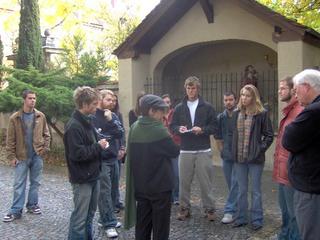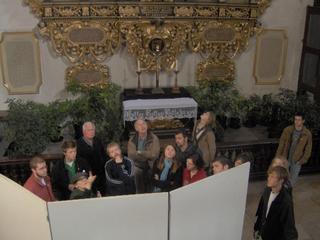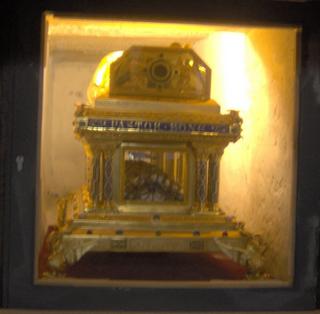St. Emmeram Monastery
 Today the art history class toured St. Emmeram Benedictine monastery which houses the remains of that saint and fragments of others.
Today the art history class toured St. Emmeram Benedictine monastery which houses the remains of that saint and fragments of others.  Naturally the rest of us went along as well.
Naturally the rest of us went along as well.Legend says the monastery was founded by St. Emmeram of Poitiers who came to ancient Roman garrison town Ratisbon (as Regensburg was once called) toward the end of the 7th Century to convert the Bavarian tribes from pagan idolatry. But that's why it's a legend. Emmerman didn't found anything.
 Although I have no hard evidence, I think that Emmeram’s mission had less to do with turning the Bavarians from idolatry (which I think would require rather more than three years) than with converting them from a competing form of Christianity known as Arianism. Arians were followers of Bishop Arius of Alexandria (d. 336) who believed that Jesus, the Son of God, could not also be the Father (of similar but not same substance).
Although I have no hard evidence, I think that Emmeram’s mission had less to do with turning the Bavarians from idolatry (which I think would require rather more than three years) than with converting them from a competing form of Christianity known as Arianism. Arians were followers of Bishop Arius of Alexandria (d. 336) who believed that Jesus, the Son of God, could not also be the Father (of similar but not same substance). This was disputed by those who believed in a Trinity (Father, Son and Holy Spirit as one). Arianism was declared heresy in 325 at the First Council of Nicaea but it took many centuries before it could be rooted out, especially among the Germanic tribes where it had been spread by pious Arian missionaries.
This was disputed by those who believed in a Trinity (Father, Son and Holy Spirit as one). Arianism was declared heresy in 325 at the First Council of Nicaea but it took many centuries before it could be rooted out, especially among the Germanic tribes where it had been spread by pious Arian missionaries. 

St. Emmeram befriended the local ruler, Theodo Duke of Bavaria, whose family had founded a small chapel to St. George around 652. Emmeram worked among the Bavarians for some three years with such success that, a century later when St. Boniface, known as the Apostle of Germany, reported to Rome on the condition of Christianity in Germany, Bavaria was the one bright spot with many churches and monasteries established and flourishing. 
 Perhaps the guilt of Duke Theodo had something to with that. It seems Ota, his daughter, had been seduced and made pregnant by one of his court nobles. She had confessed to Emmeram who told her to tell daddy it was he who had done the deed. Emmeram then decided it would be a good time to take that trip to Rome he’d been planning. So, was he trying to deflect the duke’s wrath from Ota and whoever her lover was? Or did he do it? Or was he just ...what? No matter. Enraged, the Duke sent his men after Emmeram. When they caught him at Kleinhelfendorf he was tortured, then taken to Ascheim and executed (I’ll spare you the gory details).
Perhaps the guilt of Duke Theodo had something to with that. It seems Ota, his daughter, had been seduced and made pregnant by one of his court nobles. She had confessed to Emmeram who told her to tell daddy it was he who had done the deed. Emmeram then decided it would be a good time to take that trip to Rome he’d been planning. So, was he trying to deflect the duke’s wrath from Ota and whoever her lover was? Or did he do it? Or was he just ...what? No matter. Enraged, the Duke sent his men after Emmeram. When they caught him at Kleinhelfendorf he was tortured, then taken to Ascheim and executed (I’ll spare you the gory details).
 The rest comes from the Catholic Encyclopedia: http://www.newadvent.org/cathen/05406a.htm
The rest comes from the Catholic Encyclopedia: http://www.newadvent.org/cathen/05406a.htm  It was still further enlarged by Charlemagne about the year 800 and endowed with extensive possessions and many privileges. When St. Boniface, in 739, divided Bavaria into four diocese, the first Bishop of Ratisbon fixed his see at the Abbey of St. Emmeram, but later on it was removed by a subsequent bishop to the old Cathedral of St. Stephen, which stands beside the present one.
It was still further enlarged by Charlemagne about the year 800 and endowed with extensive possessions and many privileges. When St. Boniface, in 739, divided Bavaria into four diocese, the first Bishop of Ratisbon fixed his see at the Abbey of St. Emmeram, but later on it was removed by a subsequent bishop to the old Cathedral of St. Stephen, which stands beside the present one. 
In 830, the then bishop obtained from Louis, King of Bavaria, the administration of the abbey for himself and his successors, and for upwards of a hundred years the Bishops of Ratisbon ruled the monastery as well as the diocese, but in 968 St. Wolfgang restored its independence and from that time forward it enjoyed the rule of its own abbots. 
For some centuries it was customary to elect as bishop a canon of St. Stephen's and a monk of St. Emmeram's alternately. Many of the early bishops of Ratisbon were buried in the abbey church and their tombs are still to be seen there, as also is that of the Emperor Arnulph (d. 899). The abbots held the rank of princes of the Empire, and as such had a seat in the Imperial Diets. 
The present church, which is a Romanesque basilica, dates from the thirteenth century, but was restored in a somewhat debased style in the eighteenth. It is one of the few German churches with a detached bell-tower.
The monastery was suppressed early in the nineteenth century and in 1809 the conventual buildings became the palace of the Prince of Thurn and Taxis, hereditary postmaster-general of the old German Empire, whose family still (1909) reside there. The cloister garth, in the centre of which is a modern mortuary chapel, is now used as the family burial-place. 
Two Postscripts.
One: The close historical relationship between the Benedictine Order iand Bavaria is said to be one of the pillars of Bavarian nationalism. This relationship is said to be the reason Cardinal Joseph Ratzinger, a Bavarian, took the name Benedict upon becoming Pope. One of the early goals of the Benedictine order was to root out Arianism among the Germanic tribes so it is interesting to note the New York Times editorial "The Pope without a Country" by the German commentator Martin Mosbach who wrote: Western theology has long been influenced by a creeping Arianism - the idea that Jesus was not of the same substance as God. It would be true to character if Pope Benedict were to invest all his zeal in the effort to recast the concept of the divine incarnation in a new language, which would once again render it understandable to modern-day theologians, teachers and intellectuals.
Two: There was some disagreement as to the importance in the history of St. Emmeram and Bavaria of the Cluniac Reform of the Benedictine order. In fact it was substantial. Emperor Henry III (r. 1017-1056) was a devoted proponent of the Cluniac reforms. Indeed his support laid the groundwork for the disasterous confrontation of his son Henry IV and Pope Gregory over the issue of lay investiture that ultimately brought down the Salian dynasty of German kings.

1 Comments:
While researching our visit to St. Emmermam's Abbey/Monastery I found your blog. What very interesting observations and I thank you for sharing them.
Post a Comment
<< Home